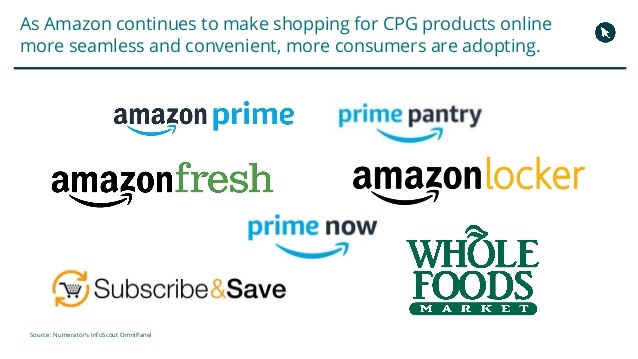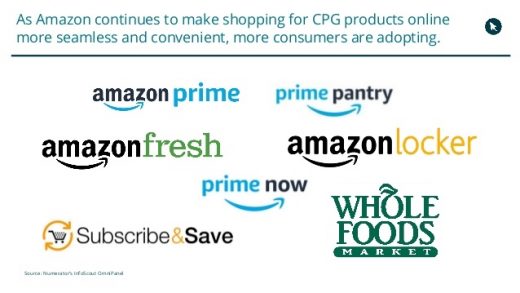The Amazon Factor: The Push To Align CPG Shopper, Brand Marketing Teams
The Amazon Factor: The Push To Align CPG Shopper, Brand Marketing Teams
For CPGs, Amazon is a proverbial game changer — not only as a powerful direct sales platform, but as a channel for testing products and garnering consumer insights.

But it’s also a complex platform with myriad ad-buying and ecommerce rules, and often-frustrating data restrictions. And the advent of competitive media platforms from retail giants including Walmart, Kroger and Target has made formulating sales and marketing strategies that much more complex.
That’s not even mentioning the scary flip side of Amazon as a potentially lethal competitor through its ability to apply massive amounts of online consumer data to its growing private label and brick-and-mortar retail businesses.
CPG marketers, agencies and consultants shared strategies for leveraging Amazon and other retail media opportunities as they continue to evolve, during a panel at MediaPost’s recent Marketing CPG conference.
To do justice to the wealth of insights, I’m covering this in two parts, starting with the challenges involved in trying to integrate shopper marketing and brand marketing in the interests of the overall strategy and optimizing both awareness and sales results. Next time, a look at metrics and buying decisions, the pros and cons of Amazon versus other retail media platforms, and other issues discussed.
Teams: In-Store, Online and Beyond
“As properties like Amazon, Walmart, Kroger and Target are building up their own platforms, traditional shopper marketers are under increasing pressure from their customers to invest in these media properties, but also under scrutiny from their brand counterparts to make sure that that media is just as effective and accountable as the traditional publishers like Facebook and Google,” said Diana Gordon, managing director for Mindshare’s Shop+ group, created specifically to help clients bridge the gaps between marketing disciplines.
“Most brands have the brand marketers and shopper marketers, but then often also define a performance team or agency or digital agency, versus a branding team,” noted panel moderator Travis Johnson, president of Dentsu Aegis Network’s Sellwin Consulting, dedicated to customizing Amazon business-building strategies for brands. “Amazon’s a unique environment, in that all of those teams have to work together.”
Johnson pointed out that Amazon “talks church and state” when it comes to the retail and advertising sides of its business, but that the terms of retail deals specify advertising spend levels. So shouldn’t shopper marketers be sitting in on meetings about Amazon strategy?
Yes, “but it really doesn’t happen,” said Nick Morrissey, senior vice president, performance media, for Havas Media. In talking brick-and-mortar retailer strategies with clients, “they’re constantly considering all of those backend costs that go along with selling their product,” he said. “But that’s not the conversation that typically happens on the client side with people managing Amazon. It’s beyond critical for those two sides to develop connective tissue — in fact, probably have the same person managing the scope of work against both.”
Finding the right talent in this brave new world spanning online and in-store is, not surprisingly, also challenging.
Amazon’s and “a lot of best brands on Amazon” are “moving to a more consultative model,” according to Morrissey. “Tried-and-true search marketers aren’t going to cut the entire gamut of what you need to make happen on the retail platforms, so people with organizational consulting experience tied in with that actual marketing experience are probably the unicorns you need for the demand-capture side of Amazon. Then when you bring in the demand generation side, you need an even rarer unicorn: someone with more branding experience, and much more ‘full-picture’ experience. That’s pretty tough to find in one person.”
“A lot of brands have one team at the company that decides how many pallets of product Walmart’s going to get versus Target, then you have the marketing team. And then you have similar groups at Amazon,” added Rob Griffin, co-founder of Rise-Alliance, a communications firm specializing in changing brand dynamics. “So because you’re factoring all of that in, you can get the best search person to cover AMS [Amazon Marketing Services], and a really good programmatic buyer to do banner and video ads within the Amazon ecosystem, but you also need people able to be more consultative to help the brand put it all together. Because I don’t think there’s really a canned best practice yet.”
“Amazon has absolutely changed the game in terms of the ecommerce shopper relationship,” stressed Bevon Dormer, head of Amazon media strategy and activation for The Hershey Company. “At the same time, the big [traditional] retailers building out media capabilities is creating a lot of friction for us as a company, along with a lot of opportunities.
“Those [retail customers] bring opportunities to our retail teams in terms of trade negotiations, and they also have the opportunity to close the loop, which Amazon is not quite able to do at the moment. Since we now put the consumer at the center of everything we do, these opportunities should also enable us to accelerate our strategies. But it means that [retail and branding] teams will have to get together and play more holistically to ensure that we optimize every touchpoint within the consumer journey.”
Hershey has been working on more aligned strategies for more than a year, but still has a lot of work to do in this regard, and has brought on new leadership to focus on this priority, Dormer said.
If a CPG company is building an in-house team for Amazon marketing, “yes, get the search and programmatic people to build a team,” added Gordon. “But if you’ve got an agency, you really need someone who can write a strong brief. Because we’ve got the tacticians who know how to deconstruct the AMS platform and build those audience and keyword strategies, but what we really need is someone on the client side to help us translate your business and marketing objectives into something that’s going to be meaningful for your organization. Then we can build the campaigns and strategies to support and achieve that.”
(17)


